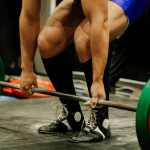
Ahhh…. That runner’s high.
It doesn’t matter what type of runner you are, the feeling post run of those wonderful endorphins is the best and VERY addictive.
So much so, people will often keep running through clear signals of back pain because they crave that “hit”.
As wonderful as running is, it does put a lot of strain on your body – simply due to the amount of repetitions your legs need to do to cover a distance.
Usain Bolt takes 41 strides to complete 100m.
Depending on your stride length, it may take you between 400-1240 strides for a 1km run. That’s a lot of repetition!
Let’s take the average person’s rate of 820 strides for a 1km run.
That equals 410 impacts per leg per 1km.
In every stride, your body needs to deal with 2.5-3 times your body weight.
So, if an 70kg person goes for a 1km run, each leg with be loaded with 86,100kg or 172,000kg through both legs!!!
Running is a pulling exercise, which means when done correctly, your hamstrings pull your foot up to your hips (don’t forget, 410 times per leg per 1km run) with support from the calves, glutes and core.
This why runners can develop powerful, lean legs as they endure significant load BUT this is also why you may be struggling with back pain post run.
I’ve been coaching for over 15 years and there are mainly two common reasons runners start to develop back pain – postural changes and muscular fatigue.
Let me explain postural changes.
Every muscle in your body has a purpose.
One purpose of the hamstring is to bend the knee. When you do this over 410 times in a 1km run, the muscle is being trained to contract and tighten.
When you bend the knee to run, your hip also has to flex, causing your hip flexors to engage and become tighter also.
When your hip flexors tighten, your pelvis tilts forward.
When your pelvis tilts forward, your discs in your spine CAN start to reposition and take uneven wear and tear.
This causes a position called “lordosis”. Severe lordosis can cause multiple back issues such as a bulging disc or nerve impingement which nobody wants!
Excessive running not done in a balanced training schedule, can lead to chronic back injuries but the good thing is your body will give you signals it’s not quite right early, you will just have to listen to it.
Now let’s talk muscular fatigue.
Every run you go on starts with a thought.
To take that thought into action requires your nerves to stimulate the correct muscles so you can run.
The nerves that control your legs start at your lumbar spine eg. lower back.
When you are “fresh”, feeling loose and full of energy the signal from your nerves to legs muscle can happen seamlessly.
You have one of those great runs where you bounce of the pavement with ease. After repetitive use, your calves, hamstrings and glutes can easily become tight.
This is a signal from your body to give these muscles assistance to reset.
If you push through, you’ll notice your ability to lift your heel up become restricted. After continuing to push on and ignore your body’s signals you can have a pulsating pain in your back.
This is a response from your body looking for help. The nerves coming from your lower back maybe be restricted due to the muscle of your calves, hamstrings and glutes being so tight and not in there correct position. At this point, the chain of muscles needed to run are exhausted and need to recharge.
This is why the body always wins. No matter how mentally tough you are you can’t avoid doing some sort of recovery.
Prehabilitation is always better than rehabilitation.
One of my clients is a national long distance runner and she continues to run 40-50km per week by having one 30 minute session with me per week. Over the past 12 months Ash has set a PB in her 5000m, 3000m, 1500m and 800m distances with not only hard work but also adding in an assisted stretch therapy session once per week.
Stretching is such an effective way to restore full range of motion in your joints and muscles. An ideal ratio would be one run, one stretch.
This is due the run contracting the muscles and the stretch lengthens the muscles causing balance. Even a simple stretch of the calves, hamstring and glutes before bed on the day of your run will help create balance in your muscles.
Remember, if you are 70kg and went a for 1km run you have put 172,000kg of load through your legs and hips. That is awesome and great for your fitness but your muscles won’t be able to sustain that effort unless they can be reset.
I absolutely love that runners high too and that’s why I’m here to help you before significant back pain prevents you from doing what you love.
Purchase our popular starter pack here and experience the stretch therapy difference in just 4 sessions (plus save $129).
Otherwise, you can book your first appointment online here



